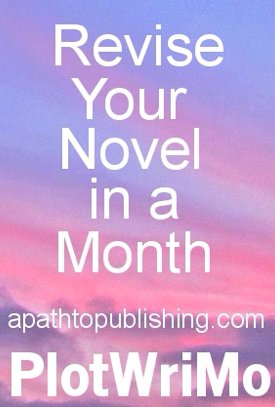- Begin a Plot Planner for your story with the protagonist's character emotional change from the beginning to the end of the story
Even though this is Book Review Friday, recent posts were all book reviews while my foot was healing up. Today I just have to share how good it feels to be up and about again. That, plus the fact that I read about 16 books in the past 5 weeks and I am experiencing "reader glut". My well has been filled with what feels like a
lake!The doctor removed the pin yesterday and gave me some truly uncomfortable toe excercises to do three times a day (but they are already taking positive effect!) Meanwhile, when I rest, my foot still needs to be elevated, but activity is good for it, so I am making a point of walking around the house as often as possible. And yesterday I had both lunch and dinner on the patio, enjoying close up and personal the garden I had been looking wistfully at out the bedroom window for 5 weeks. Listening to bird calls and watching butterflies. Feeling a faint breeze. Joy!
So, what have I been doing besides reading these past weeks? I am happy to say that I submitted 5 poems to various online sites, listened to some great writing tutorials, took notes in my notebook for my WIP,
Granny's Jig, and bookmarked magazines to submit to, and agents to query. I also started a new book, ins
pired by Martha Alderson's wonderful tutorials on plot.
Martha Alderson is "The Plot Whisperer", and her approach to plotting is one I like a lot. I first found her on Jill Corcoran's blog,
here, and oh, how I wish I were writing the books Jill Corcoran is looking for, because she gives such great advice on her site.
Today Sir Husband set up my computer and printer on a table in the livingroom so I can sit at the computer and work with my foot propped up on a comfortable padded chair. ("Sir Husband"because I knighted him a few weeks back for taking such good care of me and treating me like royalty. He's still doing that, too.) Let me just say it feels great to be hunched over my keyboard instead of balancing my computer on one knee. So my agenda today includes snail submissions for three children's poems, and some query letters for two of my books. (Cross fingers, as I send them out into the world.)
Meanwhile, I have to thank all the reading I did for how mentally massaged I feel, how ready to write again. With all that input, it's time for output again, and I'm all revved up. This is a case where deprivation made the heart grow fonder.
I also want to thank all of you for your comments during this period. It was so cheering to hear from you, and I've enjoyed maki
Thanks I get from writers for the Plot Series: How Do I Plot a Novel, Memoir, Screenplay? is an added gift.
I did the vlog (which I later learned means a video blog) on a lark with my friend
Cathy Cress , fiction writer and expert on the aging family and sibling warfare. My vlogs are on plot for writers. Cathy's vlogs
Mom Loves You Best - Forgiveness are on sibling reconciliation and forgiveness which grew out of her own life, her writing and her lifelong work. While I filmed her, I was struck how writers could benefit from the juicy and touching and horrific sibling stories she relates for creating more realistic familial back-stories and antagonists in stories and also for tips on how to heal your own personal sibling back-story.
I brought up the idea of creating vlogs. Sight unseen, no explanations needed, Cathy was in. Cathy's latest book:
Mom Loves You Best - Forgiveness was just released. The month before I had met my soon-to-be agent at a writers retreat where I was teaching plot and she was teaching about voice and being her -- a high-energy light.
Jill Corcoran of the
Herman Agency loves my plot teaching. I love everything about her.
From the hundreds of novels, memoirs and screenplays I have analyzed for plot workshops and plot retreats for more than twenty years and as I complete the final, final edit -- well, there is still the galleys to come, but still..., on the Plot Whisperer book (the cover is up on Amazon and the book ready for pre-order!), I have come to appreciate that beneath every great story beats the Universal Story.
Creative writers hate to be reined in and limited by an imposed set of generally accepted plot standards on their stories, crying out that they will be come stifled and their stories cookie-cutter.
Might I suggest instead, to see that in writing with the Universal Story, your creativity and own unique voice has a place to light, to flow into, and you will more likely stay focused and achieve that long-term goal of yours to finish your story.

By: Martha Alderson, M.A.,
on 2/19/2011
Blog:
Plot Whisperer for Writers and Readers
(
Login to Add to MyJacketFlap)
JacketFlap tags:
plot whisperer,
how do I plot a novel,
plot series,
a memoir,
youtube channel marthaalderson,
/user/marthaalderson,
keeping to the writing deadlines you make,
youtube series,
and screenplay,
Add a tag
 Nothing worse than when a writer commits to a deadline and then is unable / unwilling to accomplish the feat. Well, that's a bit extreme but too often, I see what happens when writers fail to meet deadlines.
Nothing worse than when a writer commits to a deadline and then is unable / unwilling to accomplish the feat. Well, that's a bit extreme but too often, I see what happens when writers fail to meet deadlines.
Such a failure frustrates me personally because rather than move forward in our consulting sessions, even if the writer tells me how much research she accomplished or thought she gave or plotting she did, if she is not writing, we are standing still.
Two, a writer's writing time is just that. Time to write. Not to brainstorm with others or to organize your space or to read internet news or play solitaire on your computer. Your writing time is time to write.
When breaking deadlines is chronic, though I can always cancel sessions until productivity improves, the writer's disrespect of herself costs her spirit (energy).
Once or twice is to be expected but when a writer comes up with more excuses than writing, such an abuse signals a problem.
There are two kinds of writing deadlines:
1) Deadlines imposed on you by another professional
2) Deadlines you set for yourself
Meeting the first kind of deadline is a critical if you wish to be a successfully published author. Book and magazine publishers, acquisition editors and critique groups expect you to be true to your word. Do that and you become a trusted and reliable team member.
Meeting the deadlines you set for yourself is great practice for when you are asked to keep a deadline for someone else. Also, meeting the deadlines you set for yourself is a personal message that you think enough of yourself to do what you commit to do and that you are able to count on yourself.
Be realistic when you commit to a deadline with others and with yourself.
Breakdown the total number of scenes or chapters or words you need to write overall
Divide by the number of writing days you have between now and the deadline
For every working day, schedule how much productivity is required for ultimate success
Show yourself and the muse that you are to be trusted.
Only make promises to yourself you know you can keep.
Show up for yourself.
Live up to your commitment and write.
Plot Series: How Do I Plot a Novel, Memoir, Screenplay? is playing on my YouTube channel. Currently, there are 21 Steps. Step 22 goes up later this weekend. A directory of the program is to your right. Each link takes you to a video that explains that particular writing concept.
Benefits of watching the Plot Series:
1) Become a better writer
 There is the holy trinity in the Christian religion, the holy trinity as a culinary term in all sorts of cuisine and, I hope it is not sacrilege, the holy trinity in stories. Perhaps it's a bit wacky to use the term in plot... what can I say?
There is the holy trinity in the Christian religion, the holy trinity as a culinary term in all sorts of cuisine and, I hope it is not sacrilege, the holy trinity in stories. Perhaps it's a bit wacky to use the term in plot... what can I say?
The three cornerstone scenes in all novels, memoirs and screenplays are:
However, there is another trio that is my very favorite in the
Universal Story because of the power these three scenes produce in stories and in our lives as writers and people.
I've been admonished for being a bit heavy-handed in these three videos. Please forgive me. My passion often overtakes me.
Click on green highlighted plot concepts for further explanations via video. Each time a concept is referenced you are directed to new information.
 Another example of what I call the "magic of writing." I just love it when this happens!
Another example of what I call the "magic of writing." I just love it when this happens!
In going over scenes with a writer, I ask for the
1/2 way mark / recommitment scene and lo and behold, the scene she tells me about fits the recommitment parameters perfects. She did not consciously write it that way but she also did not get in the way of letting it come naturally.
I find the less our egos interfere and the more clearly and cleanly we can act as a conduit for the muse, the more "magic" like this occurs.
Brings about a pleasing read for a reader and movie for an audience when these natural moments are let to shine.
 Please, please, please writers, be careful what you say to yourself. Stifle the urge to beat yourself up for not being perfect.
Please, please, please writers, be careful what you say to yourself. Stifle the urge to beat yourself up for not being perfect.
Unplug from all the negative self-talk and plug into affirmations. Make a list of them -- all the great things about you as a writer and if you don't believe you deserve greatness, change your belief system. You made up the story you tell yourself now. You can revise that story anyway you want. You're the author of your own life, your own story.
All that happens by trash talking yourself or your writing and being filled with doubt and insecurity is that you lose energy and thus stop writing.
What good is that?!
Please. Be gentle with yourself. Believe you have been chosen to write your story for a purpose. The muse believes in you. It's your job to begin believing in yourself!
 The fear you greet at every major threshold of your life is simply based on a fantasy of a danger that has not happened. Rather than stay frozen on the future, get out of your head.
The fear you greet at every major threshold of your life is simply based on a fantasy of a danger that has not happened. Rather than stay frozen on the future, get out of your head.
Feel your body.
Seize this moment and write something, anything.
Keep moving.
Write through the fear.
Today, detach from the outcome and concentrate on putting one world after another on the page.
Forget the duality of good versus bad.
Marvel at the miracle of words appearing out of nowhere and you writing them on the page.
Replace fear with blind trust that you will be supported and that all is well.
Make the act of writing or whatever you do an act of love...

By: Martha Alderson, M.A.,
on 10/5/2010
Blog:
Plot Whisperer for Writers and Readers
(
Login to Add to MyJacketFlap)
JacketFlap tags:
Memoir,
NaNoWriMo,
plot whisperer,
screenplay,
contest for free plot consultation,
santa cruz landmark,
Santa Cruz Traveling Mystery Tour,
Plot Series: How Do I Plot a Novel,
Add a tag
 Win a free one-hour plot consultation!
Win a free one-hour plot consultation!
PRIZES· Locals win an overnight stay at the Darling House in Santa Cruz on Valentine’s Day
· Out-of-towners win a 1-hour phone consultation with family expert Cathy Jo Cresss on sibling reconciliation and forgiveness and a 1-hour writer's plot phone consultation with plot expert to the stars Martha Alderson, aka the Plot Whisperer
More than 144 billion videos were viewed on YouTube last year. The number is expected to more than double this year.
My cohort on the Santa Cruz Traveling Mystery Tour is Cathy Jo Cress, author of the just released Mom Loves You Best; Forgiving and Forging Sibl
 Once you have your first, second, third + drafts written and you're set on the overall plot, major scenes and turning points, character growth and transformation, and have a sense of your overall theme, turn your attention to "every word perfect."
Once you have your first, second, third + drafts written and you're set on the overall plot, major scenes and turning points, character growth and transformation, and have a sense of your overall theme, turn your attention to "every word perfect."
I know, by the time you've written countless drafts, you're eager (desperate!) to send your story out for feedback from your agent or to query to entice an agent to request your manuscript. If you can hold back, take the time to print out a hard copy of your novel, memoir, or screenplay and read every word with an analytical mind -- can you pump up that common verb for a punchier one? Substitute that cliche with a fresh way of understanding her sensibilities?
Where a character lives; the clothes she wears; the car she drives; what she keeps in her medicine cabinet; her refrigerator; her make-up bag; choice of pictures on the wall of her apartment, townhouse, or mansion are all an externalization of the character's inner life and mean something.
Authentic Details in the Beginning, Middle, End:
In the Beginning (1/4) of the story, the authentic details you relay reflect the character as she is starting out the story.
In the Middle (1/2), the details shift to reflect her as she journeys into the great unknown.
The authentic details she surrounds herself with at the End (1/4) reveals the character's true, authentic details -- hers and hers alone -- and deepens the reader's understanding of who the character is now = the character's ultimate transformation.
Oh, and now is a great time to grab your pen and pad of paper and follow along with the
Plot Series:How Do I Plot a Novel, Memoir, Screenplay? to plot your next story. That way, when every word is perfect in the story you're finishing up now, you'll have the next one all plotted and ready to go... That's the plan, anyway... Hope you'll stop by...

The authentic details you identify when writing the scenes in the Beginning (1/4) show the objects the protagonist most identifies with. These objects reflect the protagonist's conditioning by her environment, upbringing, and culture.
When the protagonist moves into the Middle (1/2), she moves out of the ordinary and conditioned world into an exotic and unknown world (thus, the need to create two unique settings).
Whether she is a willing adventurer or resistant is reflected by the degree of pain caused her by the loss of these objects. Unable to base her identity on her association to her things and lifestyle, she questions who she is. Thus begins her inner plot line and creates the 1st step toward the incremental and ultimate story transformation.
Look at the objects surrounding you. What do they convey about where you are on your writer's journey? What can you let go of and move closer to where you wish to be?
 The further I put myself out there teaching, writing, consulting, living, the more vulnerable I feel.
The further I put myself out there teaching, writing, consulting, living, the more vulnerable I feel.
It's risky, following the energy out of the comfortable zone.
Inside a turtle's shell seems the perfect place to dream and imagine. It's also a good place to lick wounds. So many decisions, so much work, too challenging. Always on the edge of barely knowing.
The part that believes I'm not good enough, not smart enough, not enough whispers how easy it would be just to stop...
Safety becomes confining. Life pulses minus one.
Still... the shell is protective and cool and all mine.
So tell me. What about you? Put yourself out there for your writing today? Take any risks?
 A couple of months ago in a plot interview, Brenda Novak, author of nearly forty romance novels and more than 3 million books in print and multiple honors, shared a trick she uses when she gets "...stumped. Some people call this writer's block. I loose steam, the tension leaks out of the story and my productivity grinds to a halt. When this happens, I have to retrench to a point when I know the story was working and branch off in a new direction. Every time this happens, however, I find a better way and get excited and start churning out pages again. So I believe it's a good thing, a compass, of sorts."
A couple of months ago in a plot interview, Brenda Novak, author of nearly forty romance novels and more than 3 million books in print and multiple honors, shared a trick she uses when she gets "...stumped. Some people call this writer's block. I loose steam, the tension leaks out of the story and my productivity grinds to a halt. When this happens, I have to retrench to a point when I know the story was working and branch off in a new direction. Every time this happens, however, I find a better way and get excited and start churning out pages again. So I believe it's a good thing, a compass, of sorts."
Follow the energy...
The more energetically charged, passionate, excited, filled with possibility we are, the more energetically charged, passionate, excited and filled with possibilities our writing and writing lives are. A loss of energy is a great time to check in with yourself.
What we desire never comes from pushing. Yes, I appreciate all the examples that prove the opposite is true. However, when we are in the flow of life, there is always enough time, enough support, enough imagination, enough stamina available for whatever we put our minds to.
Keep in mind, Brenda's advice is not permission to go back and rewrite the beginning again.
Instead, give her method at try -- "retrench to a point where you know the story was working and branch off in a new direction" from there.
Let me know how it works for you.
 Writers Plot Retreat took place in the Santa Cruz Mountains in Northern California
Writers Plot Retreat took place in the Santa Cruz Mountains in Northern California
Easy access to San Jose airport


 Gorgeous private home on 25 acres of redwood forest
Gorgeous private home on 25 acres of redwood forest
 I've fallen into the habit of asking writers to fill out the Character Emotional Development Plot Profile for themselves as well as for their protagonist. One question more than all others reveals depth of passion.
I've fallen into the habit of asking writers to fill out the Character Emotional Development Plot Profile for themselves as well as for their protagonist. One question more than all others reveals depth of passion.
QUESTION: What do you stand to lose if you do not accomplish your writing goal?
WRITERS' ANSWERS:
I've lost my way and haven't been able to find it again
The evil voices will be proven correct
Sanity
My story will not make it into the world
Self-respect
Me
My self-esteem
A sense of accomplishment before the real deadline
Self-fulfillment
Peace of mind
In the work I do with writers, I offer guidance about plot and structure and meaning in relationship to the protagonist's ultimate transformation. I also strive to provide insight into the writer's journey.
Writing is a solitary activity and can make you feel cut-off and separate and alone. Until, that is, you attend your first writers conference, join a critique group, form a writing group, read blogs like this one.
Everyone who creates something out of nothing questions themselves. Who am I to write?
All writers revise endlessly.
No one knows what they truly are writing about.
Every writer is shy about the choices they make.
My greatest hope for you is to remember we all start a story the same--one word on the page at a time and to encourage you to feel your way to how this next author answers when asked the same question:
What do you stand to lose if you are unsuccessful at achieving your writing goal?
Not a thing. Everything is as it should be...
 I'm on the edge of my seat. Will she or won't she?
I'm on the edge of my seat. Will she or won't she?
I left her last time right after she had written the Crisis. Euphoric for having faced every one of her own demons in order to send her protagonist to death -- metaphorically speaking, of course. Still, she wrote it and survived. An embarrassing mass of slop? Likely. All that matters now is getting the scenes written. Before we hang up last time, I gently coax her to face what is coming. She hears my words but does turn around and thus has no idea of the size of the mountain behind her still left to scale.
This time, when she calls, I hear it the minute she speaks. For the first time since we started working together and at the base of Climax Mountain, she hits a wall. Her voice has no energy. She sounds wary. Shell-shocked. Numb and filled with disbelief.
I scramble to assess the damage and uncover something quite unexpected.
From the time she left the middle of the Middle, I worried about her writing the scenes leading up to the Crisis around the 3/4 mark and the Crisis itself. I never even considered her real demons would hit at the End on the way up to the Climax.
Both the protagonist and the writer are drug addicts. The protagonist is killing herself because of her addiction. The writer is in recovery. Not, however, for long. "Two years," she told me. "This time." Having fought my own addictions, I shiver when I heard the second part of her answer. It implies there could be a next time.
Of course, the protagonist has to hit rock bottom at the Crisis. The fact the writer survived the writing of it herself is a tribute to her heart and her spirit.
Now what I think is happening is that because the writer herself has not experienced her own personal transformation fully nor seized her own personal power, she can't quite see the way for the protagonist here at the beginning of the End.
I encourage her to let the protagonist do what she needs to do (the writer knows exactly what she wants to happen at the Climax and thus has only to get her there for now).
Let go of trying to get in the character's head and body. Write purely action now.
Ask the protagonist to reveal herself to you as the powerhouse she can and must be.
Then let her loose, sit back and watch what comes...
Like I said, I'm on the edge of my seat.
 Beginnings hook readers. Endings create fans.
Beginnings hook readers. Endings create fans.
The other night when talking about readers with a writer friend, she interrupted to comment that she did not believe many writers consider their ultimate readers when writing a story. She went on to say that most writers she knows spend most of their time perfecting the beginning and usually peter out at the end.
The next day I received an email from a mighty disappointed agent friend who had just finished a 400 page manuscript she was SO hopeful for and realized "in the last 60 pages or so there must be a book in there, somewhere," but not in the shape she needs it to be.
How many of you do endings well? Not just with your stories but in other aspects of your life, too. Ending a relationship. The end of a visit. The end of any phase. Often, we just let things peter out...
All that to say, a friend and prolific writer, Penny Warner, has a terrific blog post about beginnings. Check it out. (NOTE: I just realized all the mystery writers who make up The Lady Killers are blogging about beginning. Penny's post is on May 12th)
Martha Alderson, AKA the
Plot Whisperer, posted a great definition of plot on her blog this past week. In and of itself, that might not seem too exciting. But I loved the way she did it, by gradually adding to the definition in a way that mirrors how many of us writers approach a story. She began with plot as a series of events:
Plot is a series of scenes that show outward action.
And ended with plot as the core of a well-developed novel:
Plot is a series of scenes deliberately arranged by cause and effect to create dramatic action filled with conflict, tension, and suspense to further the character’s emotional development and create thematic significance.
As she added to the definition, she explained the significance of each story element. I particularly loved that she included thematic significance as part of the plot. It is so often overlooked, or tacked on, but when done well it is the unifying force that weaves everything in the plot together. In effect, it is what makes a great novel great. The Plot Whisperer points out, "It is the main thrust of your presentation and what you hope to prove through your story. The theme is the why: what you want your audience to take away after having read your story."
Read the full article:
http://plotwhisperer.blogspot.com/2010/04/definition-of-plot-for-writers.htmlHappy plotting,
Martina
 Go only where you feel cared for and supported; where everyone sees you as perfect.
Go only where you feel cared for and supported; where everyone sees you as perfect.
How are you doing in that department when it comes to you and your writing? Do you care for yourself enough to show up for your writing? Are you supportive of your passion for writing? Do you see yourself as perfect? Do you see your work as perfect?
The relationship we have with our writing is reflective of our relationship with ourself.
- Daily show up for your writing
- Light a candle
- Ask for guidance and support
- Begin writing
- Quit writing before you begin to lose energy for what you are doing, before you begin to trash talking your work, before you despair. Quit while you're still in the flow, feeling good about yourself and the process of creating something out of nothing on the page
- Blow out the candle
- Ask the smoke to take your thanks and gratitude for your writing to the source of all creation
Our stories represent a deep and passionate calling.
Begin a new relationship with yourself as a writer.
View Next 25 Posts
 Since, agent Jill Corcoran is such a good marketer, I am sure most of you already know about the video series that author of the PLOT WHISPERER, Martha Alderson and literary agent Jill Corcoran released three months ago.
Since, agent Jill Corcoran is such a good marketer, I am sure most of you already know about the video series that author of the PLOT WHISPERER, Martha Alderson and literary agent Jill Corcoran released three months ago.












I saw the first part yesterday and I learned a lot. Much more affordable at the lower price!
I DO believe this is somewhere in my future :) Thanks for the reminder, Kathy!
Such an amazing deal on a great product. I purchased it as soon as the price dropped into my budget. My Netflix queue is going to have to wait while I watch these videos, instead!
As an added bonus, Jill and Martha have also mentioned starting a private facebook group to support those who have purchased the videos. I can’t tell you how excited I am about that!